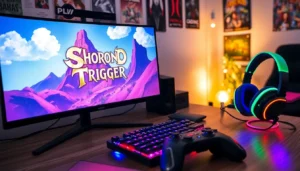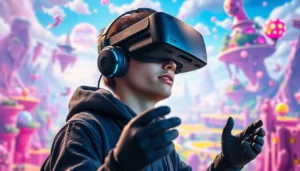Table of Contents
ToggleWhen it comes to retro gaming, few things capture the imagination like Game Boy sprite design. Those tiny pixelated characters and vibrant backgrounds transformed the way players experienced gaming in the palm of their hands. But what if the magic behind those 8-bit wonders could be unraveled?
Overview Of Game Boy Sprite Design
Game Boy sprite design encompasses the creation of characters and objects in a limited resolution, leading to unique visual styles. The Game Boy’s screen resolution of 160×144 pixels imposes certain constraints, making the design process both challenging and innovative. Colors played a significant role, with a palette of only four shades per sprite, allowing for imaginative designs while maintaining clarity.
Designers focused on simplicity to convey personality and movement through pixel art. Each sprite typically features a maximum size of 8×8 or 8×16 pixels, like those seen in iconic titles such as “Pokémon” and “The Legend of Zelda”. Artists used dithering techniques to create visual depth, enhancing the overall aesthetics despite the constraints of the color palette.
Proficiency in designing sprites required understanding pixel placement and its impact on character recognition. Faces and expressions often relied on a few key pixels to convey emotion, establishing an immediate connection with players. For instance, characters like Mario and Link demonstrated how minimal details can resonate strongly with audiences.
Animation frames, integral to sprite design, facilitated dynamic movement. Game designers utilized a limited number of frames to create fluid motion, emphasizing essential actions like running or jumping. Techniques such as sprite flipping and color cycling added variety to animations without excessive data usage.
Legacy is a crucial aspect of Game Boy sprite design; it influenced modern pixel art across various platforms. As games evolve, many developers continue to draw inspiration from these early designs, showcasing the lasting impact of Game Boy visuals. Understanding the fundamentals of sprite design leads to a greater appreciation for the artistry behind beloved retro games.
History Of Game Boy Sprite Design

Game Boy sprite design showcases a fascinating timeline within handheld gaming. The evolution of this design has sparked creativity and innovation among developers.
Evolution Of Handheld Gaming
Handheld gaming began with devices like the Nintendo Game Boy, released in 1989. This portable console introduced simple, pixelated graphics suitable for shorter gameplay sessions. As technology progressed, the graphics improved, yet the charm of Game Boy sprites remained. Iconic titles like “Tetris” and “Super Mario Land” demonstrated how effective sprite design could engage players. By limiting resolutions and color palettes, developers honed their skills in creating memorable characters, paving the way for future handheld consoles. Each advancement in handheld devices built on the original Game Boy’s foundation, influencing how games were designed and experienced.
Key Characteristics Of Game Boy Graphics
Game Boy graphics are defined by pixel art, specifically designed within a 160×144 pixel resolution. Sprites utilized a restricted color palette of four shades, necessitating creativity in character expression. Developers deployed techniques such as dithering to mimic additional colors and provide depth. These visuals conveyed emotions with minimal detail, enabling players to connect with characters. The maximum sprite sizes of 8×8 or 8×16 pixels emphasized simple yet effective designs. Recognizing these characteristics enhances appreciation for the unique style of Game Boy games. Each graphic choice contributed to the overall charm of the gaming experience.
Techniques In Game Boy Sprite Design
Game Boy sprite design employs various techniques that enhance visual appeal and functionality within strict limitations.
Pixel Art Basics
Pixel art serves as the foundation of Game Boy graphics. Character design and object creation involve placing individual pixels to form cohesive images. The simplicity of this approach allows developers to convey emotion through facial expressions and body language. Designers often focus on silhouette clarity to ensure recognition at small sizes. An effective sample includes creating distinct shapes to differentiate characters during gameplay. Overall, adept use of pixel art ensures both aesthetic value and practical gameplay mechanics.
Color Palette Limitations
Color palette limitations significantly influenced Game Boy sprite design. Each sprite could only utilize four shades, including transparency. This restriction necessitated creativity in conveying depth and detail. Designers often used lighter shades for highlights and darker ones for shadows. Strategic color placement enhanced visual clarity and character distinction. For example, varying shades of green can depict different elements of an environment. Despite the constraints, the skillful application of limited colors contributed to the iconic charm of Game Boy graphics.
Iconic Game Boy Sprites
Game Boy sprites defined an era of handheld gaming, generating unforgettable experiences through pixel art. These charming designs captivated players while establishing a lasting legacy.
Classic Titles And Their Influence
Titles like “Pokémon” and “The Legend of Zelda” exemplified effective sprite design within strict technical constraints. “Tetris” showcased how simple graphics provided deep engagement, drawing players into its addictive gameplay. “Super Mario Land” set benchmarks for character animation, pushing sprite techniques to new heights. Each of these classics influenced not only contemporaries but also future game designers, setting the standard for pixel art in handheld systems.
Memorable Character Designs
Character designs from Game Boy games remain iconic for their creativity. Link’s distinctive green tunic instantly communicates his role as a hero. Pikachu utilizes its playful expression to evoke a sense of friendliness, solidifying its place in gaming culture. Additionally, minimalistic designs convey depth and emotion, ensuring characters are memorable. Innovations like color placement and silhouette clarity are hallmarks of Game Boy sprite artistry, allowing players to connect with characters despite graphical limitations. Such designs continue to inspire both nostalgia and admiration in the gaming community.
Impact Of Game Boy Sprite Design
Game Boy sprite design significantly shaped both gaming and culture, leaving a mark that’s still evident today.
Influence On Modern Games
Modern games draw inspiration from the creative constraints of Game Boy sprites. Pixel art remains prevalent, with developers embracing the retro aesthetic to evoke nostalgia. Independently developed titles like “Celeste” and “Hyper Light Drifter” showcase this influence, demonstrating that limited color palettes and simple animations can create compelling visual experiences. Games designed with a deliberate retro style often rely on clear silhouette and careful color choices, reminiscent of their Game Boy predecessors. Successful indie games highlight how classic design principles endure, fostering emotional connections while attracting diverse audiences. They prove that sometimes simplicity and nostalgia reign supreme in game design.
Cultural Significance
Culturally, Game Boy sprites represent a transformative era in handheld gaming. They created a lasting legacy, as characters like Link and Pikachu became instantly recognizable icons. Events like “Tetris” championships and Pokémon tournaments fostered community engagement centered around these beloved sprites. Nostalgia plays a significant role in maintaining interest in retro gaming, inspiring conventions and merchandise dedicated to classic titles. Sprite design also influenced art movements, encouraging artists to explore pixel art in various mediums. As a result, Game Boy sprites not only shaped gaming history but also became cultural touchstones, connecting generations of players through shared experiences.
The legacy of Game Boy sprite design remains a powerful force in the gaming world. Its unique charm and creativity under tight constraints have not only shaped the handheld gaming experience but also inspired a new generation of developers. The artistry behind those pixelated characters continues to resonate, proving that simplicity can lead to profound emotional connections.
As modern games embrace retro aesthetics, the influence of Game Boy sprites is evident in their design choices. This enduring appeal highlights the significance of nostalgia in gaming culture, fostering a community that celebrates the past while looking towards the future. Game Boy sprites are more than just graphics; they’re a testament to the creativity and innovation that defined an era.




